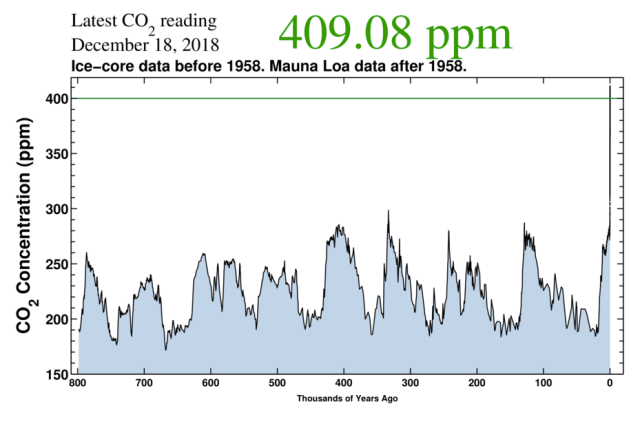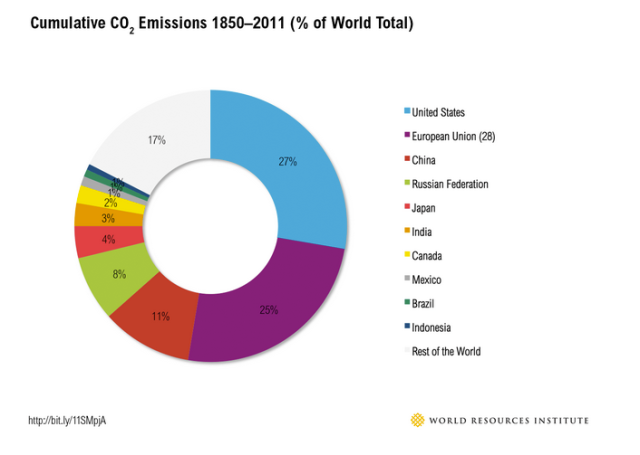The good news from the annual climate summit just concluded in Katowice, Poland, is that the world’s governments agreed on a “rulebook” intended to implement the Paris Accord, the 2015 agreement to reduce greenhouse-gas emissions. The bad news is that the world is no closer to actually tackling global warming than before and the rulebook has little binding effect.
Because these annual meetings are more about symbolism than action, it is symbolic indeed that the 24th Conference of the Parties to the United Nations Framework Convention on Climate Change (UNFCCC), or COP 24, took place in Katowice, in Poland’s coal country. For added irony, the far-right Polish government announced the opening of a new coal mine days before COP24 opened, and Poland’s pavilion featured displays of everyday items such as walls and soap made out of coal.
Admittedly the bar is awfully low, but COP24 was an improvement over last year’s COP23 gathering in Bonn, Germany, when the world’s governments talked and concluded by announcing that they would talk some more. But there were some glowing press releases issued, in which participants congratulated themselves for their willingness to talk. The official COP23 web site declared that “we have done the job we came here to do, which is to advance the implementation guidelines of the Paris Agreement.” Evidently, talking about those guidelines was considered sufficient to “advance” the Paris Accord agreements.
COP24’s contribution to advancing the Paris Accord was to agree to a rulebook with no real enforcement mechanism. In other words, the world’s governments had previously agreed to set goals for reducing their productions of greenhouse gases but to do so on a voluntary basis with no enforcement mechanism, and now those agreements will have guidelines as to how those goals will be reported that also have no enforcement mechanism. And governments will be allowed to use their own methodologies to calculate their progress, a gaping loophole sure to be used to cook the books.
If you feel underwhelmed by all this, you shouldn’t feel bad.
It is understandable that participants would like to put a positive spin on the gathering, but COP24 president Michał Kurtyka was arguably crossing into the territory of unreality with his summation:
“[I]s impact on the world will be positive. Thanks to it, we have taken a big step towards achieving the ambitions set in the Paris Agreement. Ambitions thanks to which our children will look back at some point and consider that their parents made the right decisions in an important historical moment.”
A rise of 1.5 degrees is not as bad as 2, but still bad
More likely, our descendants will curse us for doing essentially nothing to combat global warming as they evacuate from flooded coastal cities and struggle to minimize large-scale agricultural disruptions. Each year that nothing concrete is done, the likelihood of catastrophic environmental damage increases. And there are not many years left before worst-case scenarios become inevitable. Just two months ago, the Intergovernmental Panel on Climate Change (IPCC) issued a report on the effects of global warming of 1.5 degrees Celsius above pre-industrial levels and that of 2 degrees warming. There is a significant difference between the expected results of 1.5 and 2 degrees, but the effects at 1.5 are nonetheless serious. The Earth has already warmed by 1 degree, and the IPCC report states that, if current patterns continue, 1.5-degree warming will be reached between 2030 and 2052.
Thus, catastrophic changes well beyond what we are already experiencing could begin to occur in as few as 12 years.
 With a “high confidence,” the IPCC report states, “Some impacts may be long-lasting or irreversible, such as the loss of some ecosystems” if global warming is stabilized at 1.5 degrees in 2100. But the damage at 2 degrees will be significantly worse than if global warming is capped at 1.5 degrees. For example, “6% of insects, 8% of plants and 4% of vertebrates are projected to lose over half of their climatically determined geographic range for global warming of 1°C, compared with 18% of insects, 16% of plants and 8% of vertebrates for global warming of 2°C.” Further, global warming of 1.5 degrees is “expected to drive the loss of coastal resources and reduce the productivity of fisheries and aquaculture” but such losses will be more severe at 2 degrees.
With a “high confidence,” the IPCC report states, “Some impacts may be long-lasting or irreversible, such as the loss of some ecosystems” if global warming is stabilized at 1.5 degrees in 2100. But the damage at 2 degrees will be significantly worse than if global warming is capped at 1.5 degrees. For example, “6% of insects, 8% of plants and 4% of vertebrates are projected to lose over half of their climatically determined geographic range for global warming of 1°C, compared with 18% of insects, 16% of plants and 8% of vertebrates for global warming of 2°C.” Further, global warming of 1.5 degrees is “expected to drive the loss of coastal resources and reduce the productivity of fisheries and aquaculture” but such losses will be more severe at 2 degrees.
Mass species die-offs will be in our future, the report says:
“The level of ocean acidification due to increasing CO2 concentrations associated with global warming of 1.5°C is projected to amplify the adverse effects of warming, and even further at 2°C, impacting the growth, development, calcification, survival, and thus abundance of a broad range of species, for example, from algae to fish (high confidence).”
None of this is new; there have been ample studies of what runaway global warming will look like in coming decades. Reports in the past few years have found that Earth is crossing multiple points of no return and thus driving the planet “into a much less hospitable state”; that the contribution of melting ice sheets to global warming has been under-estimated, meaning that coastal flooding could happen sooner than expected; and that current and near-future global warming may be enough to cause a rise in sea levels of at least six meters.
As a reminder, the world’s governments agreed in Paris, at COP21, to set a goal of limiting global warming to 1.5 degrees instead of the previously agreed 2 degrees. But should all the pledges made at the Paris Summit actually be met, the increase in global temperatures will be about 2.7 degrees, according to Climate Action Tracker. The group calculates that fulfillment of the national pledges would result in an increase in the global temperature of 2.2 to 3.4 degrees C. (with a median of 2.7) by 2100, with further increases beyond that. In other words, global warming would advance at a slower pace than it would have otherwise should all commitments be fulfilled. But there are no enforcement mechanisms to force compliance with these goals; peer pressure is expected to be sufficient.
Governments will have to report their emissions, eventually
So what was accomplished at COP24? All countries will be required to report their emissions — and progress in cutting them — every two years starting in 2024. The climate science web site CarbonBrief reported that the same benchmark (the latest IPCC emissions accounting guidance) “shall” be used by all governments when reporting progress toward meeting pledges, but the governments who negotiated this agreement left themselves a large loophole. Joeri Rogelj, a lecturer in climate change, told CarbonBrief:
“Under the Paris Agreement, emissions and proposed emissions reductions will be regularly compared, added up, and assessed in light of their adequacy for limiting warming well below 2C and 1.5C. This requires common rules for emissions reporting. But instead of requiring countries to adhere to scientifically robust methods, the final Katowice text now allows countries to use ‘nationally appropriate methodologies’, which, in all likelihood, will only be used to do some creative reporting and portray emissions of specific countries in a better light than they are. This is particularly an issue in the land-use sector.”
Regardless of future accuracy in reporting progress, an upgrading of the national commitments made at Paris was not forthcoming. As DeSmog noted, “In the final text agreed at Katowice, countries are not specifically asked to increase their ambitions but simply ‘invited’ to consider enhancing their pledges by 2020. The Paris Agreement will kick in that year, and countries are set to re-submit or update their climate pledges.”
 National governments will be expected to boost their Paris Accord pledges in future years, but the first assessment of progress toward meeting those goals won’t be for another five years, reports Bob Henson of Weather Underground:
National governments will be expected to boost their Paris Accord pledges in future years, but the first assessment of progress toward meeting those goals won’t be for another five years, reports Bob Henson of Weather Underground:
“Each country is being encouraged to ratchet up its Paris Agreement pledges every five years: in 2020, 2025, and beyond. Three years after each round of pledge revisions, starting in 2023, there will be a “global stocktake” session, where progress is juxtaposed against the latest science and the goal of achieving equity. This year’s meeting was a pre-stocktake of sorts, intended to hammer out the rules of how the pledges (or nationally determined contributions) will be verified and updated.”
There was at least some comic relief at COP24, predictably supplied by the Trump administration. Wells Griffith, Donald Trump’s adviser on energy and climate change, gave a presentation promoting increased use of fossil fuels, including coal, drawing animated protests and derisive laughter. Mr. Griffith quite literally ran, for a reported quarter-mile, from Democracy Now reporter Amy Goodman as she attempted to question him, at one point claiming he was being “harassed” because he was being asked questions.
Such antics are not likely to be found amusing by our descendants should they have to live through the predicted scenarios. The changes that will be necessary to reverse global warming and stabilize the global climate will come at large expense, and require that those whose jobs depend on greenhouse-gas producing industries such as oil, gas and coal be provided with new jobs. Those in the advanced capitalist countries will have to consume less, which could be accomplished in significant part through ending planned obsolescence and making products last two or three times longer. But business as usual is simply unsustainable.
As difficult as the cost that must be borne will be, the cost of doing nothing, as the world’s governments, beholden to corporate interests, are currently doing, is much greater.

Mr. Dolack,
Regarding ocean pH correction and CO2 removal from the atmosphere, here’s my proposal. http://www.timothymaloney.net/Virgin_Earth_Challenge.html
Mr. Maloney,
I will note you are thinking big, but I respectfully suggest we would do much better to stop adding so much carbon dioxide into the atmosphere rather than relying on techno-fixes.
Heck yes ! First stop adding CO2.
Only then start removing.
You want to “save the planet”? Stop having kids! There, problem solved. We’re overpopulated, period. But of course, that would involve genuine sacrifice, so can’t have that.
Structural solutions, rather than individual solutions, are what we should be looking at in facing structural problems. Although it is certainly true there is a carrying-capacity limit to the planet, there are enough resources to go around for the present population but those resources are badly maldistributed through a global system that can’t function without endless growth and a rapacious need for ever bigger profits.
If individual actions are meaningless, and only “structural solutions” matter then I’d have to say we’re doomed(probably are anyway in the long run), given the lack of serious governmental/corporate action(COP24 being a relevant example) to stop the destruction of the biosphere. Additionally, your “present population” hasn’t stopped growing, and projections are to hit at least nine billion ( some estimates I seen go as high as eleven billion). I don’t think there’s a snowball’s chance in hell that resources would ever be equally/fairly distributed, when the vastly more likely scenario is for individual consumption to rise in those places where it is currently low(China, India, etc.), while the current high consumers (US for example) continue to do so at the same or even higher levels. There is probably no other single act the average citizen can take ( short of suicide) can have as great an impact on curtailing future environmental destruction than to forswear having children. I’m not so naive as to believe that enough people will do this to make a meaningful difference.
Of course there are things we can do as individuals, but whatever we do — such as recycling, reusing, making dietary changes or even some folks opting to not have children — simply won’t add up to enough difference on their own. If we are unable to force through the institutional changes that are necessary, such as a rapid phase-out of fossil fuels, then we (or more specifically, our descendants) are doomed.
As to population control, the best answer is to educate women. In the advanced capitalist countries, natural population growth is stagnant or actually declining; growth in most of these countries comes through immigration. As women are educated and join the labor force in large numbers, the childbirth rate drastically declines, sometimes below replacement level. Obviously, the availability of birth control is a large part of this picture, but that availability goes hand-in-hand with breaking down patriarchy and women having more control over their lives and bodies.
Well your institutions are, in the main, following the advice of people like Nobel laureate Paul Norhaus who preaches that an “optimal” target for warming is 3.5 C over preindustrial levels.
So, I’d say the only real hope, very slim as it may be, is mass individual action. Face it, a large percentage of the world’s population is oblivious, uncaring, in total denial or simply stark staring nuts. Unfortunately, those running the show make up a healthy slice of that percentage.
“A striking new poll from Yale’s Program on Climate Change Communication shows that 70 percent of Americans believe that environmental protection is more important than growth—and this is true even in deeply Republican states.” (from above article)
The smart money says we and the rest of the biosphere are doomed, short of some kind of revolution. Voting, protesting, taking polls isn’t going to get it done, certainly not in time to matter.
[…] via World’s governments indulge in symbolism, not action, at COP24 — Systemic Disorder […]